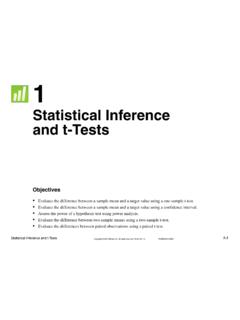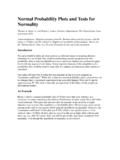Transcription of Getting Started with Minitab 18
1 Minitab 19. Getting Started with Minitab 19 for Windows 2019 by Minitab , LLC. All rights reserved. Minitab , Companion by Minitab , Salford Predictive Modeler , SPM and the Minitab logo are all registered trademarks of Minitab , LLC, in the United States and other countries. Additional trademarks of Minitab , LLC can be found at All other marks referenced remain the property of their respective owners. Release 2. Contents 1 The The Minitab user Data Open and examine a In the next 2 Graphing Create, interpret, and edit Create and interpret Arrange multiple graphs on one Save a Minitab In the next 3 Analyzing Summarize the Compare two or more Save the In the next 4 Assessing Create and interpret control Create and interpret capability Save the In the next 5 Designing an Create a designed View the Enter data into the Analyze the design and interpret the 40. Use the stored model for additional 44. Save the In the next 6 Repeat an Perform an analysis using session 48.
2 3. Getting Started with Minitab 19 for Windows Contents Copy session Use an exec file to repeat the Save the In the next 7 Importing and Preparing Import data from different Prepare the data for your When data values Save the 4. 1 Introduction Overview Getting Started with Minitab 19 for Windows introduces you to some of the most commonly used features and tasks in Minitab . Most statistical analyses require that you follow a series of steps, often directed by background knowledge or by the subject area that you are investigating. Chapters 2 through 5 illustrate the following steps: Explore data with graphs and present results Conduct statistical analyses Assess quality Design an experiment In chapters 6 and 7, you learn to do the following: Use shortcuts to automate future analyses Import data into Minitab from different file types and prepare the data for analysis The story A company that sells books online has three regional shipping centers.
3 Each shipping center uses a different computer system to enter and process orders. The company wants to identify the most efficient computer system and to use that computer system at each shipping center. Throughout Getting Started with Minitab 19 for Windows, you analyze data from the shipping centers as you learn to use Minitab . You create graphs and perform statistical analyses to identify the shipping center that has the most efficient computer system. You then concentrate on the data from this shipping center. First, you create control charts to test whether the shipping center's process is in control. Then, you perform a capability analysis to test whether the process is operating within specification limits. Finally, you perform a designed experiment to determine ways to improve those processes. You also learn how to use session commands to automate future analyses and how to import data into Minitab . The Minitab user interface Everything you see in the Minitab interface is part of your project.
4 5. Getting Started with Minitab 19 for Windows Introduction The Minitab interface includes the following components: 1: Navigator Contains the list of output titles in your project sorted from oldest to newest, with the most recent output titles at the bottom of the list. Right-click any output title in the Navigator to do the following tasks: Open the output in split view to compare it to the output on a different tab. Rename the output. When you rename the output, the name updates in the output pane. Send the output to a different application, such as Word, PowerPoint, or Companion by Minitab . Delete the analysis from the project. You can undo this action from the Edit menu. Tip If your project has multiple worksheets, you can view the list of output by worksheet. From the Navigator, click and choose Group Commands by Worksheet 2: Output pane Displays output, such as graphs and tables, after you run an analysis. Output for each analysis is displayed on a single tab.
5 From the output pane, you can do the following tasks: To affect the contents of a tab, click the tab, then click next to the output title. To affect a specific table or graph, click the graph or the table, then click . To view output that is not currently visible, click the title of the output in the Navigator. Tip To compare the output of two different analyses, right-click the second piece of output in the Navigator and choose Open in Split View. 6. Getting Started with Minitab 19 for Windows Introduction 3: Data pane (worksheets). Displays the active worksheet. You can have multiple worksheets open in the data pane at the same time; however, Minitab uses the data in the active worksheet to run the analysis. Tip To rename a worksheet, double-click the name in the worksheet tab. 4: Command Line/History pane By default, this pane is not shown. To show this pane, choose View > Command Line/History. If you close Minitab while the pane is visible, the pane is visible the next time you open Minitab .
6 Command Line The location where you can enter or paste command language to perform an analysis. History The command language that Minitab uses to run an analysis. You can select and copy commands and subcommands from the History pane to the Command Line pane, where you can edit and run them again. 5: Status bar Use the status bar to show or hide the Navigator, the data pane, or the output pane. You can also zoom in or zoom out on a graph or a worksheet, depending on whether the data pane or the output pane is selected. Click to show or hide the Navigator. Click to show the output pane and the data pane at the same time. Click to show only the data pane. Click to show only the output pane. Data types A worksheet can contain the following types of data. Numeric data Numbers, such as 264 or Text data Letters, numbers, spaces, and special characters, such as Test #4 or North America. Date/time data Dates, such as Mar-17-2019, 17-Mar-2019, 3/17/19, or 17/03/19.
7 Times, such as 08:25:22 AM. Date/time, such as 3/17/19 08:25:22 AM or 17/03/19 08:25:22. Open and examine a worksheet You can open a new, empty worksheet at any time. You can also open one or more files that contain data, such as a Microsoft Excel file. When you open a file, you copy the contents of the file into the current Minitab project. Any changes that you make to the worksheet while you are in the project do not affect the original file. 7. Getting Started with Minitab 19 for Windows Introduction The data for the three shipping centers are stored in the worksheet, Note In some cases, you need to prepare your worksheet before you begin an analysis. For more information, go to Importing and Preparing Data on page 52. 1. Open the sample data, The data are arranged in columns, which are also called variables. The column number and name are at the top of each column. C1-T C2-D C3-D C4 C5-T C6. Center Order Arrival Days Status Distance 1 Eastern 3/4 8:34 3/8 15:21 On time 255.
8 2 Eastern 3/4 8:35 3/7 17:05 On time 196. 3 Eastern 3/4 8:38 * * Back order 299. 4 Eastern 3/4 8:40 3/8 15:52 On time 205. 5 Eastern 3/4 8:42 3/10 14:48 Late 250. In the worksheet, each row represents a single book order. The columns contain the following information: Center: shipping center name Order: order date and time Arrival: delivery date and time Days: delivery time in days Status: delivery status On time indicates that the book shipment was received on time. Back order indicates that the book cannot be shipped yet because it is not currently in stock. Late indicates that the book shipment was received six or more days after the order was placed. Distance: distance from the shipping center to the delivery location In the next chapter Now that you have a worksheet open, you are ready to start using Minitab . In the next chapter, you use graphs to check the data for normality and examine the relationships between variables. 8. 2 Graphing Data Overview Before you perform a statistical analysis, you can use graphs to explore data and assess relationships between the variables.
9 Also, you can use graphs to summarize data and to help interpret statistical results. You can access Minitab 's graphs from the Graph and Stat menus. Built-in graphs, which help you interpret results and assess the validity of statistical assumptions, are also available with many statistical commands. Minitab graphs include the following features: Pictorial galleries to help you choose a graph type Flexibility in customizing graphs Graph elements that you can change Option to be updated This chapter explores the shipping data worksheet that you opened in the previous chapter. You use graphs to check normality, compare means, explore variability, and examine the relationships between variables. Create, interpret, and edit histograms Before you perform a statistical analysis, first create graphs that display important characteristics of the data. For the shipping data, you want to know the mean delivery time for each shipping center and how the data vary within each shipping center.
10 You also want to determine whether the shipping data follow a normal distribution, so that you can use standard statistical methods for testing the equality of means. Create a paneled histogram To determine whether the shipping data follow a normal distribution, create a paneled histogram of the time lapse between order date and delivery date. 1. If you are continuing from the previous chapter, go to step 2. If not, open the sample data set, 2. Choose Graph > Histogram. 9. Getting Started with Minitab 19 for Windows Graphing Data 3. Choose With Fit, and then click OK. 4. In Graph variables, enter Days. 5. Click Multiple Graphs, and then click the By Variables tab. 6. In By variables with groups in separate panels, enter Center. 7. Click OK in each dialog box. Note To select variables in most Minitab dialog boxes, use one of the following methods: Double-click the variables in the variables list box. Highlight the variables in the list box, and then click Select.










